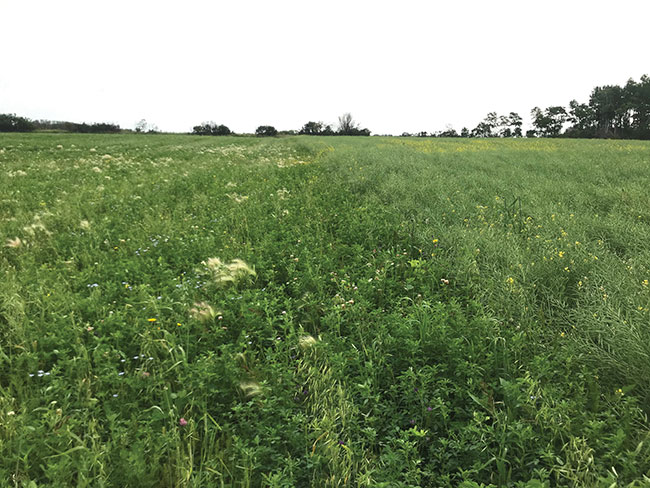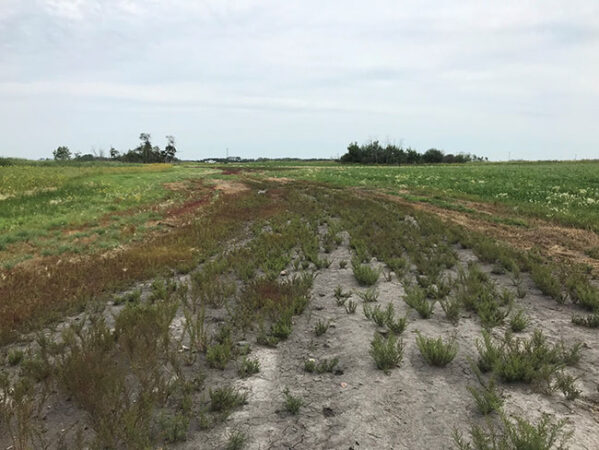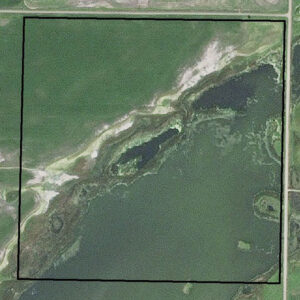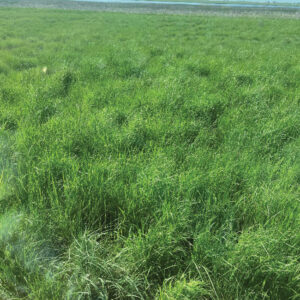
Features
Environment
Restoring marginal land with forages
Ducks Unlimited is paying producers to restore perennial forage on less productive grainland.
June 28, 2023 By Julienne Isaacs
 Before photo illustrate the effects of the MAP on another operation.
Photos courtesy Charlotte Crawley
Before photo illustrate the effects of the MAP on another operation.
Photos courtesy Charlotte Crawley A range of benefits follows planting forages in marginal areas damaged by compaction, erosion or salinity issues.
This is a message producers have probably heard dozens of times. But this time, they could get paid for the practice, says Charlotte Crawley, a farmer in Rapid City, Man., and agrologist for Ducks Unlimited Canada (DUC).
DUC’s Marginal Areas Program started as a pilot project in Saskatchewan in 2018 that aimed to restore acres of annually cropped fields that are not suited to grainland production. Producers who sign on are paid $150 per acre in exchange for a commitment to leave those areas in forages for ten years.
The pilot expanded to Manitoba in 2019 and has grown steadily since then, says Crawley. Last year, DUC signed 550 acres in Manitoba. The goal for 2022 is 1200 acres across the province.
Most producers sign for an average of 25 acres, but there’s no acre minimum to qualify. DUC does compliance checks to ensure the areas are left in forages; contracts are pro-rated in case producers want to buy out early. These areas can be mowed, cut for hay or left idle–there are no restrictions on use.
“If you have reduced yield, or in the worst-case scenario, bare ground or white surface salt, you’re producing zero yield on those acres. I know it’s enticing to try to farm [there], but you’re not going to break even on those acres,” says Crawley.
“We say we’re taking [these areas] out of annual crop production, but on the flip side, when you look at that expense, those areas are costing producers money right now.”

After photo illustrate the effects of the MAP on another operation.
Photos courtesy Charlotte Crawley
Salinity
In Manitoba, marginal areas tend to suffer from salinity, compaction or erosion.
Salinity, which can become a bigger issue in flooded areas or wet years, can heavily impact yield–but it can also exacerbate other problems, like the spread of salt-tolerant invasive weeds such as kochia and foxtail barley. Forages can take a little while to establish on saline patches, but eventually out-compete those weeds and keep salinity down.
“With salinity, it’s not the salts that are the problem, but the water. If there are salts that’s causing a problem but the salts are rising higher with a higher water table,” explains Marla Riekman, a land management specialist for Manitoba Agriculture. “When we have too much moisture and that water movement goes up instead of down, you have water evaporating from the surface and leaving salts behind.”
Forages help by keeping the ground covered, pushing the water table down and increasing infiltration, which keeps salts away from the surface.
Riekman says it can be a tough sell for producers to take marginal spots out of production and seed forages, especially if those areas are in the middle of fields.
For the last 15 years, she’s been promoting forage strips along field borders, where they’re less likely to be seen as obstacles, and where they can help manage roadside salinity issues. Roads change the hydrology of the field edge, she explains: because roads are purposely compacted and ditches are designed to hold and move water, areas along ditches tend to have a higher water table, allowing salts to wick up and cause salinity issues along field edges.
“Farmers aren’t really keen to put a forage in, especially if they don’t have a neighbour to come in and cut it for them,” she says. But they don’t have to harvest the alfalfa; they could simply mow it, she adds.
In severely saline areas, alfalfa isn’t the best forage choice–farmers would do better to choose a crested wheatgrass variety such as AC Saltlander, a green wheatgrass bred for high salt tolerance.
In wet areas that aren’t severely saline, alfalfa can be an excellent choice for keeping the water table down.
“Species selection is critical,” agrees Crawley. “As long as you’re selecting the right species for an area, you’ll have pretty good success. Quite typically it’s those fringe areas around slough edges that [farmers] are targeting. But I’m also seeing it becoming more of an issue in compacted field edges.”
Compaction and erosion
It can be useful to think of forages as surface protection in vulnerable areas. This is also the case in compacted or highly erodable areas.
“If it’s a soil prone to wind or water erosion, that has issues with gullies, that’s one of those situations where you want to consider whether that area is productive. [If] these areas are not highly productive, you’re not making piles of money on them, so why waste a bunch of inputs trying? You’ll get them working for you in a different way, even if you don’t have someone who wants to graze livestock,” says Riekman.
Forages can be helpful to help break up compaction, too, but Riekman warns that they are not a one-size-fits-all solution.
If areas are extremely compacted, forages might not work.
“I’ve seen a naturally compacted soil that had a natural very dense layer about two feet down. The alfalfa could not push through that,” she says. “When we have extreme compaction we can’t rely on plants to push their way through; they’ll grow where it’s easiest to grow. It’s like plants growing through cracks in the sidewalk.”
There’s some data to support the idea that forages can increase trafficability in compacted fields, Riekman adds. But she says some of the fields that are most affected are alfalfa fields that have been hayed for many years. “You can really compact the heck out of those fields,” she says. “It’s not the one thing that will fix or manage compaction. We still have to be really cautious about how we move over soil.”
“Managing” or “fixing”?
Can forages remediate problem areas, so they can be returned to grain production? That’s a hard question to answer, says Riekman, and it depends on a lot of factors. But the short answer is, not always.
Soil scientists look at “agriculture capability,” a seven-class ranking system for soils that measures their suitability for dryland farming based on soil property, landscape and climate limitations.
“We recognize that there are some soils that have low agriculture capability potential, which means that it really does not matter what you plant on it, it’s not going to be highly suitable for annual crop production,” says Riekman.
She remembers seeing fields that had been kept in forages for 15 years; when commodity prices climbed, the farmer tilled them up. For a couple of years the farmer didn’t have any problems, but then they put down soybeans, which are not tolerant to saline conditions, and had a crop failure.
“So it was in forages 15 years ago, but it wasn’t ‘fixed,’” says Riekman. “The forage was managing it. The natural problem didn’t go away. There are cases like that where some soils are just not meant to grow certain crops.”
Crawley agrees. “One of the things I want farmers to know is that the reality is you may always have salinity problems in those fields,” she says. “It might help to shrink those areas, but [the need for] perennial forages in those areas long-term might be a reality.”
As a farmer herself, Crawley says she understands the challenges associated with grain production. “As equipment gets larger and costs go up, you want to maximize what you’re getting off every acre that you own. I think it comes back to the fact that not every acre is suited to grain production. [Sometimes] you’ll wish you had never broken an area.
“It’s kind of unfortunate that there aren’t more grain farmers incorporating forages into their field margins or acres, because the benefits of including forages are immense, especially in the years when there’s flooding. The farmers who have had forages in the last ten years are probably sitting a lot better than those who haven’t,” she says.
Riekman believes farmers may need more than a one-time financial incentive to leave land under protective cover. “Sometimes a one-time payment might be useful, but not all farmers will be interested. An ongoing payment annually might make more sense. It’ll depend on the farmer,” she says.
Manitoba Agriculture hosts a “Forages for Improving Saline Soils” factsheet on its website, as well as a factsheet on the benefits of including forages in rotation. The factsheets can be found at gov.mb.ca/agriculture/crops/crop-management/forages.

